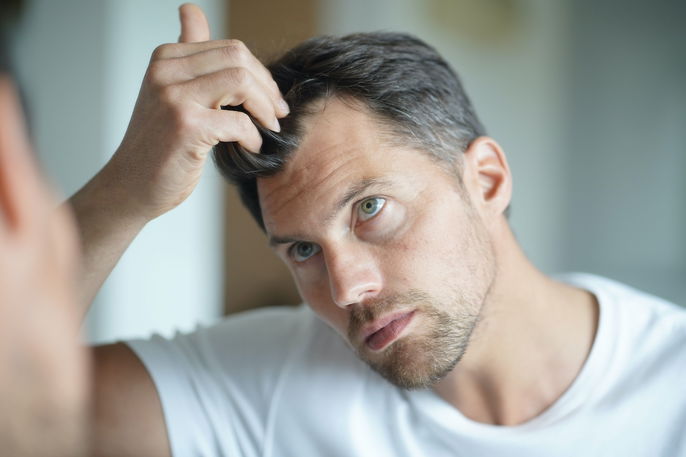Androgenetic alopecia is hair loss that occurs due to a genetic predisposition, which leads to thinner and sparse hair growth. It can affect both men and women.
Hair loss can begin at any age after puberty, but it is more common in older adults (especially after the age of 50) and more common in those with a family history of baldness.
If you are losing hair and suspect you may have androgenetic alopecia, you are advised to consult a dermatologist to confirm a diagnosis and start treatment. Treatment for androgenetic alopecia be done with medications (like minoxidil and finasteride), a hair transplant or laser therapy.

Main symptoms
Androgenetic alopecia can cause symptoms like:
- Thin hair strands;
- Thinner hair;
- Hair loss, especially on the top of the head;
- Hairline recession
Hair loss can begin after puberty and, although it is slow, it tends to gradually worsen. Symptoms of androgenetic alopecia may also differ between men and women.
Female androgenetic alopecia
Women with androgenetic alopecia will tend to notice that the front of the scalp is most affected. Although the hairline can remain intact, the hair strands starts to become thinner or finer.
Androgenetic alopecia in women can sometimes lead to more hair loss than usual, but it is rare for hair on the top of the head to be affected, or for women to lose their entire head of hair.
Male androgenetic alopecia
Androgenetic alopecia in men tends to first affect hairless above the forehead, which gradually works its way to the top of the head. This is also referred to as male pattern baldness.
Confirming a diagnosis
Androgenetic alopecia is diagnosed by a dermatologist, who will start by identifying the pattern of hair loss the patient is experiencing, and assessing for a family history of hair loss and baldness.
The dermatologist may perform a dermoscopy to observe hair strands more closely, as well as order blood tests (like a ferritin or thyroid hormone test) to rule out other causes of hair loss. A scalp biopsy may also provide insight into n the blood and, sometimes, a scalp biopsy, to confirm the diagnosis.
Possible causes
Androgenetic alopecia is associated with an abnormal response of hair follicles on the scalp to androgen hormones, like dihydrotestosterone. This abnormal response is often related to a genetic predisposition.
Although androgenetic alopecia can begin to develop after puberty, it is more common in older men and in women after menopause. It is most noted after the age of 50, and in those with a family history of baldness.
Also recommended: What Causes Hair Loss? (11 Reasons & How to Treat) tuasaude.com/en/hair-lossTreatment options
Treatment for androgenetic alopecia should be guided by a dermatologist, who may recommend the following options:
1. Topical solutions
Topical solutions, such as minoxidil, may be prescribed by the doctor for the treatment of androgenetic alopecia, as it improves blood circulation in the scalp, promoting the absorption of nutrients in the hair bulb, and promoting hair growth.
Minoxidil should be applied directly to the skin of the scalp and results may take between 4 and 8 months to be noticed.
Also recommended: tuasaude.com/enAnother topical medication that may be indicated is finasteride in the form of a solution or gel, for androgenetic alopecia in men.
2. Oral medications
Oral tablets or capsules that your doctor may prescribe for androgenetic alopecia include:
- Finasteride or dutasteride, for men
- Spironolactone, for women.
These medications should only be used as prescribed by a dermatologist, as dosing and treatment duration can vary from case to case.
3. Hair transplant
A hair transplant is a type of surgical treatment for androgenetic alopecia that may be recommended if other treatments are unsuccessful.
Also recommended: 9 Simple Tricks to Make Your Hair Grow Faster tuasaude.com/en/how-to-make-hair-grow-fasterIs there a cure for androgenetic alopecia?
There is no cure for androgenetic alopecia. However, in some cases it is possible to stop further hair loss and stimulate new hair growth with the right treatment.






























